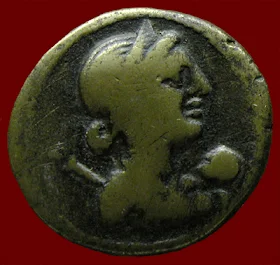Κολοσσιαίο
πορτραίτο του Καισαρίωνα, γιου της Κλεοπάτρας και του Ιούλιου Καίσαρα, 1ος π. Χ.
αιώνας, Αλεξάνδρεια. Ανήκε σ’ ένα άγαλμα
5 μέτρων και βρέθηκε στο αρχαίο λιμάνι της Αλεξάνδρειας απέναντι από το νησί
Αντίροδος.
Εν
μέρει για να εξακριβώσω μια εποχή,
εν
μέρει και την ώρα να περάσω,
την
νύχτα χθες πήρα μια συλλογή
επιγραφών
των Πτολεμαίων να διαβάσω.
Οι
άφθονοι έπαινοι κ’ η κολακείες
εις
όλους μοιάζουν. Όλοι είναι λαμπροί,
ένδοξοι,
κραταιοί, αγαθοεργοί·
κάθ’
επιχείρησίς των σοφοτάτη.
Aν πεις για τες γυναίκες της γενιάς, κι
αυτές,
όλες
η Βερενίκες κ’ η Κλεοπάτρες θαυμαστές.
Cleopatra VII with baby Ptolemy XV Caesarion son of
Julius Caesar on coin of Cyprus 47BC displayed in the British Museum.
Όταν κατόρθωσα την
εποχή να εξακριβώσω
θάφινα το βιβλίο
αν μια μνεία μικρή,
κι ασήμαντη, του
βασιλέως Καισαρίωνος
δεν είλκυε την
προσοχή μου αμέσως.....
Ανάγλυφο που
αναπαριστά την Κλεοπάτρα και το γιο της Πτολεμαίο Καίσαρα, Ναός της Άθωρ στα
Δένδερα. A relief of Cleopatra VII and Caesarion at the temple of Dendera, Egypt.
A, να, ήρθες συ με
την αόριστη
γοητεία σου. Στην
ιστορία λίγες
γραμμές μονάχα
βρίσκονται για σένα,
κ’ έτσι πιο
ελεύθερα σ’ έπλασα μες στον νου μου.
Σ’ έπλασα ωραίο κ’
αισθηματικό.
Η τέχνη μου στο
πρόσωπό σου δίνει
μιαν ονειρώδη
συμπαθητική εμορφιά.
Και τόσο πλήρως σε
φαντάσθηκα,
που χθες την νύχτα
αργά, σαν έσβυνεν
η λάμπα μου —άφισα
επίτηδες να σβύνει—
εθάρρεψα που
μπήκες μες στην κάμαρά μου,
με φάνηκε που
εμπρός μου στάθηκες· ως θα ήσουν
μες στην
κατακτημένην Aλεξάνδρεια,
χλωμός και
κουρασμένος, ιδεώδης εν τη λύπη σου,
ελπίζοντας ακόμη
να σε σπλαχνισθούν
οι φαύλοι —που
ψιθύριζαν το «Πολυκαισαρίη».
(Από τα Ποιήματα
1897-1933, Ίκαρος 1984)
Κωνσταντίνος Π.
Καβάφης
Kaisarion
David Hockney, Kaisarion
with all his beauty
Partly to throw light on a certain period,
partly to kill an hour or two,
last night I picked up and read
a volume of inscriptions about the Ptolemies.
The lavish praise and flattery are much the same
for each of them. All are brilliant,
glorious, mighty, benevolent;
everything they undertake is full of wisdom.
As for the women of their line, the Berenices and
Cleopatras,
they too, all of them, are marvelous.
2,500 years old: A statuette of a boy pharaoh dating from the 5th century BC lies among other artefacts brought to the surface from an underwater excavation of a palace and temples of Cleopatra.
When I’d verified the facts I wanted
I would have put the book away had not a brief
insignificant
mention of King Kaisarion
suddenly caught my
eye...
Ptolemy II Philadephus, his sister-wife Arsinoe II, and his sister Philotera. From Alexandria, Vatican Museum, Rome.
And there you were with your indefinable charm.
Because we know
so little about you from history,
I could fashion you more freely in my mind.
I made you good-looking and sensitive.
My art gives your face
a dreamy, an appealing beauty.
And so completely did I imagine you
that late last night,
as my lamp went out—I let it go out on purpose—
it seemed you came into my room,
it seemed you stood there in front of me, looking just
as you would have
in conquered Alexandria,
pale and weary, ideal in your grief,
still hoping they might take pity on you,
those scum who whispered: “Too many Caesars.”
Translated by Edmund Keeley/Philip Sherrard
C.P. Cavafy






Δεν υπάρχουν σχόλια:
Δημοσίευση σχολίου